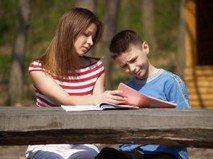|
|
Autism Behavior Characteristics

Autism Behavior Characteristics. Autism is a neurological disorder that affects language and cognitive development in young children.
Symptoms of autism begin to become noticeable between the ages of 2 - 3 years.
Children with autism look no
different than typically developing children and can only really be diagnosed through observed behavior, and by their
results on cognitive and language assessments.
Autism Behavior Characteristics cont...
Three of the more observable autism behavior characteristics are impairments in communication, social exchange, and repetitive routines.
Lets look at these in some detail...
Communication: Children with autism are perhaps most affected by their difficulty communicating to others. The difficulty is usually evident in both verbal communication and non-verbal communication. Verbal communication includes comprehension of other's speech and using spoken language
in a meaningful way. Non-verbal communication includes body language, such as using and interpreting facial expression, gesture - such as pointing - and awareness of
social rules on personal space, etc.
In worse case scenarios, children with autism may present with no speech, or have significantly delayed speech and language. Whereas children with high functioning autism, though they use good grammar and have functional language, may have difficulty with social communication.
Social exchange: Social exchange is related to communication. All social exchange relies on social language skills, or to use the technical term, pragmatic language skills. Children with autism have great difficulty understanding and adapting to social rules and social norms.
For instance, children with autism often have an inability to play cooperatively with their peers. An example might be a child with autism playing a game of basketball with his classmates.
The game can descend into chaos when the child with autism, having no toleration for other children's idiosyncrasies and who sticks rigidly to the game's rules, attempts to control all aspects of the game.
Of course, this behavior doesn't go down too well with children with typical social
language skills. More often however, children with autism choose not to interact with their peers at all, and instead will happily play for hours either lining up objects or sitting at a computer playing a favorite computer game.
Routines: Children with autism often need routines, which they follow rigidly and generally rely on. If their routine is disrupted they can become anxious and distressed. Repetitive behaviors such as repeating words or sentences over and over (echolalia)and
hand or finger flapping are also characteristic of autism.
Autism Intervention:
Carol Gray's, Social Stories
| |



